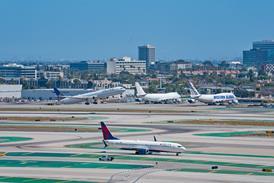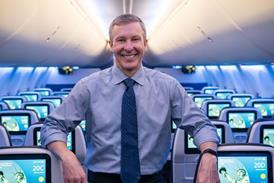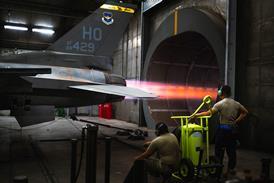Bureaucratic failings have limited Air India's growth for decades. But with privatisation looming, the airline may at last be able to reverse the situation
Chris Jasper/MUMBAI
After 33 years with India's flag carrier - including more than three at its helm - Air India's managing director Michael Mascarenhas is to stand down this year following the partial privatisation of the airline he joined as a 24-year-old. But although Mascarenhas speaks with enthusiasm of New Delhi's policy of "disinvestment", his frustration at decades of government neglect of what he regards as a prime national asset is almost palpable. For him, it is not so much Air India's privatisation that has been delayed, but the commitment to modernisation that the disinvestment programme represents.
"There are two main goals in the disinvestment process - to raise money for the government and to ensure the growth of the airline," Mascarenhas says. "The aim for Air India will not merely be to maintain market share, but to make up lost ground."
Some of that ground has been lost, it can be argued, through delays in the privatisation process itself - although senior sources at Air India suggest the slow pace of a liberalisation that began in 1991 was inevitable, given the sensitivities surrounding the airline sector.
"Indian airline culture has generally been opposed to the involvement of foreign capital," says one source. "That's partly because there is a clear precedent against that from abroad - no-one is as protectionist as the USA, for example - but also because of concerns over 'inappropriate' shareholders infiltrating the process, and over defence sensitivities."
The source adds: "It's also easy to forget that the reforms started in 1991, when the country was bankrupt, while more recently the stability of the Congress Party government has gone. Now, 10 years on, we are at last ready for the next step."
| AIR INDIA: LIKELY BIDDERS |
| Tata Group/Singapore Airlines Air France/Delta Air Lines (yet to declare an Indian partner but thought to be talking with India Tobacco Swissair/Sabena (yet to declare an Indian partner) Emirates (yet to declare an Indian partner) Hinduja Group (no declared airline partner) Steel magnate LN Mittal of Ispat International and financier Kotak Mahindra, advised by British Airways and Qantas |
Systemic failings
Mascarenhas acknowledges that the government "has always been supportive" of Air India, but adds that "the system is too slow and cumbersome and multi-tiered" to allow it to successfully manage a major airline. Pointing out that Air India was a larger carrier in the late 1960s and early 1970s than it is today, Mascarenhas says systemic failings have for decades all but strangled the airline's growth.
While the government has signed a series of bilateral air service agreements over the past few years, for example, failing to expand aircraft fleets accordingly has left Air India and sister-carrier Indian Airlines (which also operates international routes) able to use only 45 of the 92 treaties.
"This country is exploding with growth and everyone else can get in because of the bilaterals, but we are static," Mascarenhas says. "We have only a 20% [share] of all traffic in and out of India on a daily basis - yet 20 years ago it was 44%. That's because we have not grown. Indian Airlines has another 11%, but that still makes only 31% of the international market.
"If we had grown the way we were in the 1950s and 1960s we would be two or three times our current fleet size. And we would have at least retained our market share."
The chief focus of Mascarenhas' frustrations is the tortuous process of getting government approval for aircraft orders. "Aircraft acquisition can take five or seven years because there is so much decision-making to go through," he says. "I draw up a business plan and go to the ministry and they are supportive, but then I also have to go to the pre-Public Investment Board [PIB]. The PIB has inherited all the classic features of a British bureaucracy that even Britain has dismantled! It is a systemic failure. We are not asking for money; we are simply asking to be allowed to go through the international financial markets."
The ordering process alone can take five years, compared, Mascarenhas says, with no more than three to six months at competitors such as Emirates or Singapore Airlines. "On an originating traffic basis, Emirates probably has 45%-plus of Dubai traffic," he says.
Fleet expansion
Mascarenhas believes part-privatisation should be followed by a push to expand the airline's fleet and operations. "The size of the Indian international market as an originating market and in terms of growth is big - bigger than the domestic market, which is unusual. There is also growth in business traffic plus scope for new hubs and for us to exploit the bilaterals," he says. "So the fleet is half of what it should be. We could grow at two or three aircraft per annum at first and then accelerate, so that we could easily double our fleet in five years."
Mascarenhas believes that even very rapid expansion could be undertaken profitably, given India's massive potential. "We want to generate cash and we want the margin to be there immediately," he says. "But the markets are untapped and the foreign carriers are having a ball, pressing for more entry and capacity and gateway points. Growth may slow to 3%, but we can worry about that once we have started serving the existing untapped markets."
Mumbai-based Air India has four core markets, which are primarily serving overseas Indian residents of the Middle East, South-East Asia, Europe and North America. It has evolved a fleet plan based around three categories of aircraft in anticipation of post-disinvestment expansion.
Air India already has a high-capacity, long-range capability in the form of a small fleet of Boeing 747s that serve major long-haul destinations, such as the lucrative route to New York via London. It wants to augment this fleet by adding small-capacity, long-range 250-seat aircraft (in the Airbus A330-200/300 and Boeing 767-300/400ER categories) serving medium- to long-haul routes such as Frankfurt, Tokyo and London (alone), possibly from cities such as Chennai. Then it could win point-to-point traffic that now hubs with foreign carriers.
| AIR INDIA: FLEET | |
| Boeing 747-400 | 6 |
| Boeing 747-200/-300 | 6 |
| Airbus A310 | 9 |
| Airbus A300 | 3* |
| Total | |
| Requirements | |
| Boeing 747-300 Combi | 3** |
| Airbus A310 | 3*** |
| Airbus A330/Boeing 767 | 6**** |
| Airbus A320 family/Boeing 737 | 6***** |
| Notes: * Due to be sold to Indian Airlines, but no deal yet signed. ** Tender issued. To serve lower density routes. *** To be taken from Singapore Airlines and GECAS by April. **** Small-capacity, short-range requirement. ***** Small-capacity, long-range requirement. | |
Short-haul plans
Mascarenhas also lists a requirement for small-capacity, short-range (SCSR) 125-150-seater aircraft in the Airbus A320/Boeing 737-400 category. This would allow for greater frequencies on short-haul routes to the Gulf and within Asia, and for new operations to the 19 state capitals (out of 28) that it does not already serve. The SCSR fleet also aims to provide "feeder traffic within India", operating, Mascarenhas says, "from behind our gateways of Bombay, Delhi and Chennai". This in turn would increase direct competition between Air India and Indian Airlines (see opposite).
Air India will continue to operate a fourth class of aircraft for some time, retaining its Airbus A310s for route development after shedding its A300s. It is also hoping to take three 747 Combis in the short-term to operate on low density European routes on which it is losing money.
Mascarenhas would happily see Air India join a global alliance, while admitting his airline "would get a lot more from them than we are going to give", since it would be unable to deliver domestic feed to its allies. Interest from overseas carriers (restricted to a 26% stake) is nevertheless high - with New Delhi granting a two-week extension for technical bids, apparently to allow airline bidders to seal partnerships with the mandatory Indian partners.
Source: Flight International























